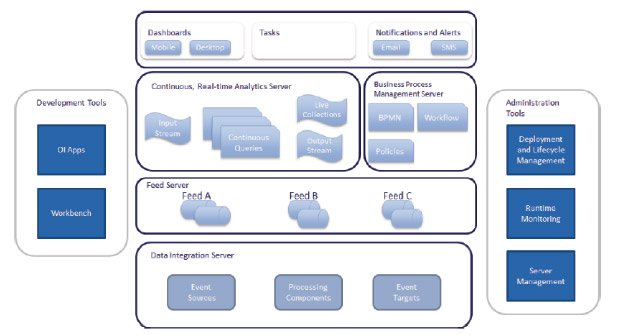Operational Intelligence – BPM with bells on?
At the end of January this year, I had a briefing from Dale Skeen, Chief Technology Officer of Vitria, concerning their new offering, Operational Intelligence Platform.
The first question I asked is what Vitria means by the term Operational Intelligence. Skeen explained, “Operational Intelligence (OI) is a form of real-time dynamic, business analytics that delivers visibility and insight into business operations. OI solutions run query analysis against live feeds and event data to deliver real-time visibility and insight into business and IT operations. This real-time information can be acted upon in a variety of ways: alerts can be sent, business processes can be triggered and executive decisions can be made and implemented using live dashboards.”
Vitria OI is designed to continuously consume large volumes of both streaming and stored data. The stream processing engine within it continuously queries, filters, correlates, integrates, enriches and analyses this data to discover exceptions, patterns, and trends that are presented through live dashboards. It sounds impressive and, having seen the demo, it does look impressive. So what does Vitria OI consist of?
It consists of a series of OI Apps:
- Activity Discovery: The Activity Discovery App lets business users uncover and analyse actual business patterns—typical paths, exception paths, and bottlenecks—from live streams of data to proactively respond to uncovered insights. It helps them visualize and analyse each transaction or activity as it unfolds.
- Activity Tracker: The Activity Tracker App simplifies tracking activity that spans businesses and application silos. It lets business users leverage a ‘discovered’ activity pattern or easily map out the major business milestones that they want to monitor in real-time, delivering unparalleled visibility into end-to-end processes.
- KPI Builder: It helps business users see trends, predict problems, and optimise outcomes using the auto-generated dashboards.
- Dashboard Builder: The Dashboard Builder App lets users create interactive and intuitive live dashboards that can be shared quickly.
StreamBuilder: Business users can access and integrate live streams of data for immediate analysis and action.
Workbench: More sophisticated OI applications, complete with feeds, complex event processing queries, processes, policies and dashboards, can be graphically composed by IT architects using the Development Workbench.
Skeen states that the result of building solutions using Vitria OI Apps is continuous and incremental analytics significantly eliminates the latency in decision-making.
Vitria OI has an extensive connector framework which allows for rapid integration with an organisation’s existing business intelligence (BI) and data warehousing infrastructure, NoSQL databases and other Big Data frameworks.

Figure 1: Vitria PI Architecture (Source: Vitria)
Central to Vitria OI is its real-time analytics server that is powered by a stream processing engine. It is event-driven, allowing a user to request analysis once, and then have that request continuously and incrementally evaluated over time against one or more event streams. As the engine is based on an event-driven architecture it is able to tackle large volumes of raw events in real time by correlating events from diverse data sources and by aggregating low-level events into business-level events so as to detect meaningful patterns and trends.
Vitria OI provides a distributed data integration framework to tap into various sources of data and events and prepare the data for analysis. These include:
- Transactional data: data that is captured from live transactions during business operations and processes;
- Streaming big data: includes data from user-generated content through social media, click streams, web and software logs, sensor data, smart grid, network and device data;
- Reference data: typically non-volatile and non-transactional in nature. It is often used to enrich other raw data, in real-time, to provide contextual information;
- Metadata: ‘data about the data’. Covers data definitions;
Analytical data: user-consumable ‘intelligent data’ that is derived as a result of analysing transactions and big data.
The same framework is also used to publish analytical data to external systems.
Vitria OI has an integrated BPM suite, which is based on the BPMN 2.0 standard, which provides support for:
A modeller for building BPMN 2.0 compliant processes and workflows.
A BPM engine capable of directly executing BPMN models, including assignments, escalations, attachment check-lists and state management.
- A rules engine for rule-based task assignments—supports both workload-based, round robin and custom rules.
- Automated responses based on policies, processes, and workflow.
- Inter-process communication using an event-driven architecture.
- A set of integration capabilities with processes including HTTP, web services, JDBC, REST, JavaScript and JMS.
- In-flight instance monitoring and management.
Vitria OI’s Dashboard capability is HTML5 compliant, ensuring that they can be viewed on both desktop and tablet devices. The results of the analytics engine can be displayed with anomalies and exceptions able to be highlighted. Business users are able to drill in to specific activities or transactions to get the context and take appropriate action.
OI has a set of development tools which are model-driven but provide support for both business and IT users. The final set of tools are there to administer the environment in terms of configuration management as well monitoring.
So how does Vitria’s OI solution fit with this view of the business need? Well it certainly has the infrastructure component all in place and ones that are well tested. It also has, from what I have seen, a very good analytics capability—especially if you are looking at not just identifying what your processes are but also getting real-time statistics to help with your management of them. This is where Vitria provides a very good solution.
Watch this space for an update on Operations Management.
